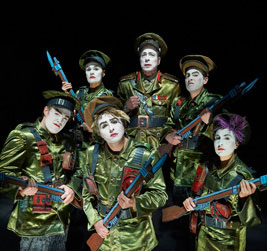Canadian Theatre Encyclopedia
Hollingsworth, Michael
Playwright, born 1950 in Swansea, Wales and emigrated in 1956 to Toronto at the age of five.
Strongly influenced by the rock music of the 1960s, his first play, Strawberry Fields (Factory Theatre 1973) took its name from John Lennon’s song, and depicted the violent consequences of a rock concert. Clear Light (Toronto Free Theatre 1973) features LSD, urban angst, and the Watergate scandal, accompanied by a wailing saxophone. It was closed by the Morality Squad for alleged obscenity.
In 1976 Hollingsworth and his partner, Deanne Taylor (one of the Hummer Sisters, a political cabaret troupe), co-founded VideoCabaret, integrating videotape, music, and theatre. Productions included Punc Rok, Cheap Thrills, White Noise, Trans World (Toronto Free Theatre 1979), and Electronic Eye. He also adapted George Orwell’s Nineteen Eighty-Four (1978) and Aldous Huxley’s Brave New World (Toronto International Theatre Festival 1981), again incorporating music and video in the productions.
VideoCabaret's most ambitious work, initiated in 1982, is The History of the Village of the Small Huts. It is a satirical retelling of the nation’s history, tracing the evolution of the Canadian “identity” as a comedy of manners in eight Parts under the subtitles: “New France” (five one-act plays), “The British” (four one-act plays), “The Mackenzie-Papineau Rebellion” (two acts), “Confederation and Riel” (two acts), “Laurier” (two acts), “The Great War” (two acts), “The Life and Times of Mackenzie King” (two acts), and “World War II” (two acts). The text was published by Blizzard in 1994.
In his Preface to the published text, Hollingsworth explains that his historical epic is made for an audience “raised on rock music and TV. In the age of electronic information, sixty scenes an hour sets a proper pace. It is the goons of history in their very own ‘Goon Show.’ It is the Canadian ‘Book of the Dead,’ a merry tale told by ghosts and demons.” It refutes the lie that Canadian history is dull.
Hollingsworth gleaned his historical characters and plot from The Dictionary of Canadian Biography, added visual images from popular culture, and employed the farcical satiric style of Monty Python and the British TV puppet show, “Spitting Image,” combined with improvisation and carnivalesque comic exaggerations. Each Part of The History of the Village of the Small Huts is written and performed in a style appropriate to the time period: the "New France" plays are written in the classical French styles of Rabelais and Corneille, the Jesuit mystery plays and Moliere; “The Plains of Abraham” is a Georgian comedy; “The Mackenzie-Papineau Rebellion” is a Punch and Judy show; “The Great War” is a Dadaist cabaret; "World War II" is Brechtian.
In her introduction to the published text, Michele White describes the characteristics of the production: “Against a black void, the actors, in an exercise of sheer precision move in tandem with hundreds of computerized lighting cues. They act out the hyperbolic facial and body gestures which the lighting technique and absence of physical location demands of them. Through body language created almost entirely from their heads and trunks, in their overblown physical attire, the performers, alone, must signal to the audience all the sense of place the text requires – from the muddy street of Hochelaga to the beaches of Dieppe.”
Parts I to III of The Village of Small Huts premiered at Theatre Passe Muraille in 1985, 1986, and 1987. Part IV, “Confederation and Riel,” premiered at the Olympic Arts Festival, Calgary in 1988; Part V at TPM in 1991; Parts VI, VII and VIII at The Theatre Centre in 1992, 1993 and 1994.
A series sequel, entitled The Global Village brings the history of Canada to the present with four more Parts, including “Trudeau and the FLQ” (1997), and finishing with “Life and Times of Brian Mulroney,” (co-written with Deanne Taylor, VideoCabaret at The Cameron House, Toronto, 1999).
In 2012, the Stratford Festival hosted the VideoCabaret production of The War of 1812 (dir. Hollingsworth) in the Studio Theatre Annex. Originally the final part of "The British," it is a scathing portrayal of the idiocies and brutalities of the cross-border war, initiated by US President James Madison on a whim, and costing Tecumseh's First Nations their land and lives. Eight actors evoke armies and generals, Laura Secord and her cow, and Tecumseh and the Prophet through clever quick changes of costume and facial alignment. "Shards of light frame the actors, and brief blackouts edit their appearances and vanishings" (Deanne Taylor, Stratford program guide). In June 2012, it played at the Magnetic North Theatre Festival in Ottawa. It won Dora Awards for Acting Ensemble, Direction and Costume Design, and also earned nominations in the categories of Lighting, Sound and Production.

Soulpepper Theatre Company co-produced Trudeau and the FLQ in March 2014 with VideoCabaret. In 2013, VideoCabaret became a resident company alongside the Soulpepper Theatre Company at the Young Centre for the Performing Arts. In April, 2016, it produced The Great War to critical acclaim. It won a Dora Mavor Moore Award for an ensemble production.
Hollingsworth was awarded a Dora Award for “Confederation” in 2004.
Deanne Taylor, one of Toronto's most imaginative and dynamic theatre figures, died of cancer in December 2020.
VideoCabaret website: http://www.videocab.com/
Profile by Anne Nothof, Athabasca University
Last updated 2022-07-27

